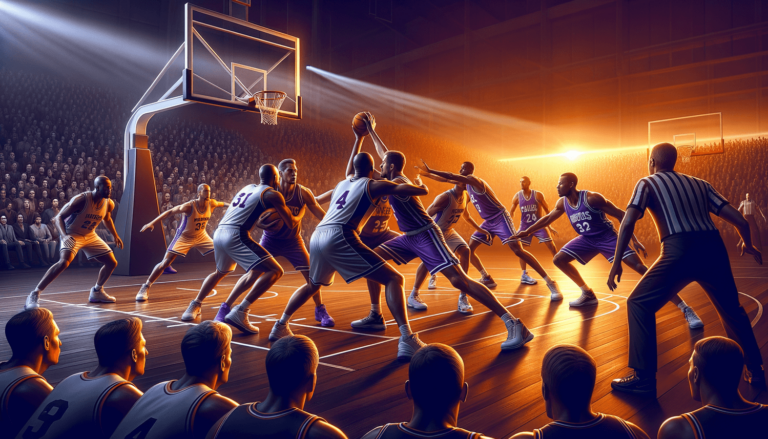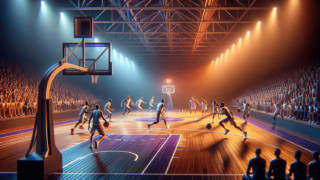
Moving Screen Rule in Basketball
Written by: Basketball Universe
Last updated:

So, you’ve got the fever for the fascinating world of hoops, and now you’re eager to explore the nitty-gritty of basketball rules. Buckle up and prepare to swish into the intriguing universe of the moving screen rule. Imagine a scenario where a player’s sneaky moves give their teammates an unfair advantage over the defenders – well, that’s precisely what the moving screen rule addresses. As we dribble down this exciting lane of basketball knowledge, you’ll discover not only what the rule is all about, but also its importance in maintaining the competitive balance and flow of the game. Let’s get the ball rolling!
Moving Screen Rule in Basketball
The moving screen rule in basketball prevents offensive players from illegally impeding a defender’s movement while trying to create an advantage for their teammate. This occurs when an offensive player sets a screen without being stationary and maintaining a legal guarding position, which consists of having both feet on the floor and the screener’s arms close to their body. If a moving screen is called, it results in a personal foul against the screener, and the defending team gains possession of the ball.
Mastering the Legal Screen
Before we dive into the moving screen rule itself, it’s essential to understand the fundamentals of setting a legal screen in basketball. The act of screening involves an offensive player positioning themselves to obstruct the trajectory of a defender to create an advantage for a teammate. A legal screen can create valuable openings and stretch the defense, making it a crucial offensive tool in basketball. Now that you’re well-acquainted with the concept, let’s delve into some crucial characteristics of a legal screen:
Legal Guarding Position
Establish and maintain a legal guarding position is critical to set a successful and legitimate screen. Here’s what constitutes a legal guarding position in basketball:
- Feet on the floor: The screener must have both feet on the floor during the entire process of setting the screen. Any attempt to move or reposition yourself while your teammate is maneuvering around your screen creates an illegal obstacle, resulting in a moving screen call from the referees.
- Body alignment: The screener’s body must remain well-aligned, with their shoulders squared up with the defender, and facing them directly.
- Arms and elbows: While setting a screen, the screener must keep both arms and elbows in close proximity to their body. Extending them outwardly to impede a defender’s movement is, as you might’ve guessed – illegal!
Distance and Timing
The moving screen rule’s core is closely associated with two essential elements – distance and timing. Being in control of these two aspects increases your chances of setting a legal screen:
- Distance: Be mindful of the distance between you and the defender before setting a screen. The screener must be one step, approximately one stride length, away from a stationary defender or two steps away if the defender is in motion. This allows the defender enough room to change their path.
- Timing: Timing is everything in basketball! When setting a screen, avoid contact with the defender until you have established a legal guarding position. It is crucial to communicate effectively with your teammate to help in your timing and better execute screens.
Spotting the Moving Screen: Red Flags
Now that you’re well-acquainted with the components of a legal screen, let’s discuss the telltale signs of a moving screen violation. Recognizing these red flags will help you better understand the nuances of the moving screen rule in basketball:
Shifting Feet
One of the most common signs of a moving screen is when the screener shifts their feet while setting the screen. Continuously repositioning or shuffling your feet to interfere with a defender’s movement is not allowed. Remember, the screener’s feet must remain on the ground while setting the screen for the obstacle they create to be considered legal.
Extending Arms or Legs
Extending or flailing your arms, elbows, or legs in an attempt to create additional contact with a defender is another sign of a moving screen violation. As highlighted earlier, the screener must retain their arms and elbows close to their body throughout the entire process, ensuring natural body contact with the defender.
Body Movement
Leaning or swaying into a defender as they move around the screen is sometimes subtle, but it’s still a violation of the moving screen rule. It is essential to maintain your legal guarding position and not intentionally initiate contact with a defender.
Consequences and Penalties
Violating the moving screen rule comes at a cost. Let’s explore the consequences and penalties enforced on players who are caught committing a moving screen offense:
Personal Fouls
When a referee calls a moving screen, the screener will be charged with a personal foul. Personal fouls accumulate throughout a game and may lead to disqualification if a player exceeds the allowable number (usually five to six fouls, depending on the league).
Change of Possession
In cases where a moving screen is called during a live-ball situation, the defending team gains possession of the ball. This change of possession can potentially disrupt an offensive team’s flow, reducing their chances of scoring and giving invaluable opportunities to the opposing team.
Strategies to Evade the Moving Screen Call
As a smart and savvy basketball enthusiast, you’ll want to be equipped with some strategies to avoid the dreaded moving screen call while playing. Employ the following tactics, and you’ll be all set:
Effective Communication
Clear communication with your teammates can make a world of difference when setting screens. By informing your teammates and providing cues about your intentions to set a screen, you allow them ample time to react, making it easier to avoid moving screen violations.
Proper Footwork
Having quick and precise footwork enables you to establish a legal guarding position faster. Working on foot speed and pivot drills would be beneficial in not only evading moving screen challenges but improving your overall basketball skills.
Body Control
Mastering the art of body control can drastically reduce the chances of committing a moving screen violation. Spend time refining your skills to maintain a legal guarding position and avoid unnecessary body movement while setting screens.
Basketball Rules: Common Misconceptions
It’s time to dispel some common myths and misconceptions pertaining to the moving screen rule in basketball:
Stationary Screeners can Initiate Contact
A widespread misconception is that as long as the screener is stationary, they can initiate contact with the defender. It is essential to understand that the screener must not only be stationary but also establish a legal guarding position before any contact occurs.
Screeners can Extend Arms or Legs to Create Space
Extending arms or legs is often seen in attempting to justify space created during screens. However, even when positioned adequately, extending arms, elbows, or legs beyond the screener’s natural body proportions to create more space or impede the defender is still considered illegal.
Why is the Moving Screen Rule Important?
The moving screen rule might seem like a minor aspect to casual observers, but it has far-reaching implications on the game and its competitive spirit. Here are some reasons why the rule is essential in basketball:
Fairness and Balance
Adhering to the moving screen rule ensures that teams can strategize and compete fairly. It’s crucial within basketball rules to maintain a level playing field and allow for honest competition.
Player Safety
Setting illegal screens can increase the risk of significant injuries, such as collisions or falls, to both the screener and the defender. By enforcing the moving screen rule, basketball promotes the well-being and safety of all players on the court.
Uninterrupted Gameplay
When screens are set legally, the game proceeds smoothly, leading to fewer stoppages due to foul calls, thus maintaining the flow of the game. The moving screen rule contributes significantly to ensuring a fast-paced and engaging gameplay experience that fans worldwide enjoy.
Universal Basketball Language
While the moving screen rule may vary slightly across different leagues and levels of play, the concept remains categorized as an illegal move within the universal lexicon of basketball rules. This consistency ensures that players can transition seamlessly between leagues and levels, minimizing disruptions caused by constantly adapting to new rules.
Conclusion
Now you’re all set to be both a well-informed spectator as well as a better-rounded player. By understanding the nuances associated with the moving screen rule in basketball, you’re not only demonstrating your expertise in basketball rules but also gaining a deeper appreciation for the countless strategies and intricacies that make the game as enthralling as it is. So next time a defender maneuvers around a sneaky screen, you’ll not only know the rules, but you’ll also be able to appreciate the finesse, skill, and knowledge that makes the game of basketball truly special.
Understanding the Referee’s Role
Now that you’re versed in the moving screen rule and its implications on the game, it’s crucial to understand the role of referees in identifying and calling moving screens. Basketball referees are trained professionals who enforce the rules and maintain game integrity, and being aware of their responsibilities will give you greater insight into managing moving screens both as a player and a fan.
Referee Positioning
Referees must be well-positioned on the court to observe and enforce moving screen rule violations. They continually move and adjust their vantage point to monitor the complex interplay between offensive and defensive players. Referees also use teamwork and communication to collaborate on ensuring accuracy in their calls.
Common Signals
When a referee identifies a moving screen violation, they will use specific hand signals to communicate the call both to the players and the scorer’s table. For a moving screen, the referee will extend their arm outward and use their other hand to mimic the motion of “scrubbing” or “wiping” their extended arm. This signal helps everyone on and off the court understand the nature of the violation and its consequences.
Learning from the Pros
One of the best ways to appreciate the nuances of setting a legal screen is to watch professional basketball players in action. Observing their on-court strategies and techniques can spotlight the do’s and don’ts of screening and further your understanding. Let’s explore why studying professional basketball can be a valuable resource:
Analyzing Successful Screens
By observing professional matches, you can witness the immense impact legal screens have on offensive gameplay. Proficient players tactically deploy screens to create space, enabling their teammates to get a clear shot or drive toward the basket. Studying game footage can be beneficial in adopting skillful screening techniques.
Identifying Moving Screens
Professional games also give you an opportunity to notice instances of moving screen violations and understand the gravity of their impact on gameplay. Detecting such scenarios in high-stakes games can be an effective learning tool when working on your screening fundamentals.
Mastering Teamwork and Communication
Observing how professional teams effectively communicate to execute well-timed, legal screens can be insightful when trying to enhance your communication skills on the court. Adopting such lessons in your game can make a significant difference in producing seamless screen execution.
Practice Makes Perfect
Being armed with the theoretical knowledge of both the moving screen rule and the ideal approaches to avoid rule violations, it’s time to put these insights into practice. To truly master the art of legal screening and steer clear of moving screen penalties, you should work on perfecting the following aspects of your gameplay:
Drills and Training
Participate in drills and training exercises designed to improve your footwork, body control, and timing, all of which play an essential role in setting legal screens. Regular practice will enable you to internalize the process, making it second nature on the court.
Scrimmages
Engaging in scrimmages and simulation games is an excellent opportunity to put your skills to the test in real-time action. The dynamic nature of basketball requires honing your skills through practice, repetition, and match-like scenarios.
Feedback and Adjustment
Last but not least, seeking constructive feedback from your peers, coaches, or mentors can expedite your journey to mastering the nuances of legal screens in basketball. Use their insights and expertise to make informed adjustments, refining your technique and minimizing any potential moving screen violations.
As a well-rounded player and appreciative spectator, understanding the moving screen rule in basketball is essential. While theoretical knowledge is crucial, remember that deliberate practice and real-life application are vital in building your skills and athleticism. By being informed, observing professionals, and continually making efforts to improve, you will undoubtedly contribute to maintaining the unique balance in the world of basketball and revel in the exciting strategic game that we all know and love.
FAQ: Moving Screen Rule in Basketball
Below are ten frequently asked questions related to the moving screen rule in basketball, addressing various aspects of this rule and offering concise explanations. These answers will further consolidate your understanding of the rule, its importance, and its implications on the game.
1. What constitutes a legal screen in basketball?
A legal screen occurs when the screener establishes a legal guarding position, with both feet on the ground, arms and elbows close to the body, shoulders squared, and facing the defender directly. The screener must be stationary and maintain this position during the screen, allowing the defender to change their path.
2. How far should the screener be from the defender while setting a screen?
The screener should be one step (approximately one stride length) away from a stationary defender or two steps away if the defender is in motion. This distance allows the defender enough room to react and change their direction without hindrance.
3. What are the consequences of a moving screen violation?
If the moving screen is called, the screener is charged with a personal foul, which can eventually lead to disqualification when the player exceeds the limit set by the league. Also, the defending team gains possession of the ball after such a violation.
4. Can a player extend their arms or legs while setting a screen?
No, the player must keep their arms, elbows, and legs close to their body while setting a screen. Extending them outwardly to impede a defender’s movement constitutes a violation.
5. What happens when a player commits a moving screen?
When a player commits a moving screen, the referee will call a personal foul against the player. The defending team will gain possession of the ball, and the offensive team loses their opportunity to score during that possession.
6. How can I avoid committing a moving screen?
To avoid committing a moving screen, maintain a legal guarding position throughout the screen, remain stationary, communicate effectively with your teammates, and practice proper footwork and body control to keep up with the defender’s movements.
7. Why is the moving screen rule important for the game of basketball?
The moving screen rule is essential for maintaining fairness, balance, and competitive spirit in basketball. It prevents players from gaining an unfair advantage through illegal movement, promoting player safety and ensuring uninterrupted gameplay.
8. What should I look for in analyzing professional basketball to understand legal screens better?
While watching professional basketball games, observe the players’ positioning, footwork, body control, and communication during screen execution. Pay attention to the referees’ calls and their hand signals for moving screen violations to better understand the nuances of the rule.
9. What is the best way to practice setting legal screens?
Participate in drills, training exercises, and scrimmages designed to improve your footwork, body control, and timing. Seek feedback from your peers, coaches, or mentors to identify areas for improvement and make adjustments in your game accordingly.
10. How can I learn more about legal screening and other basketball rules?
Studying official basketball rules for your specific league, participating in basketball training camps or clinics, seeking guidance from knowledgeable coaches, and research resources such as articles, videos, or books can all contribute to deepening your understanding of legal screening and other basketball rules.
Featured Posts
- No pillar pages found.





